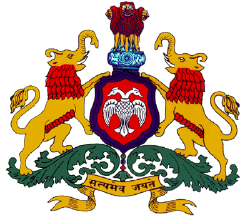|
|
| (3 intermediate revisions by the same user not shown) |
| Line 1: |
Line 1: |
| | {{Main page article box| | | {{Main page article box| |
| | type=Featured| | | type=Featured| |
| − | title=Swaminarayan| | + | title=Karnataka| |
| − | image_name=Sahajanand Swami.jpg| | + | image_name=Karnataka emblem.png| |
| − | image_desc=Swaminarayan under a [[Neem]] tree in [[Gadhada]]| | + | image_desc=Emblem of Karnataka| |
| − | text='''Swaminarayan''' ({{lang-gu|સ્વામિનારાયણ}}, [[Devanagari]]: स्वामीनारायण, [[IAST]]: ''{{IAST|Svāmīnārāyaṇa}}'') (April 3, 1781 – June 1, 1830), also known as '''Sahajanand Swami''', is the founder of the Swaminaryan Sampraday, a vibrant expression of contemporary [[Hinduism]], in the [[Vaishnavism|Vaisnavite]] tradition. | + | text='''Karnataka''', a [[States of India|state]] in the southern part of [[India]], was [[Unification of Karnataka|created]] on November 1, 1956, with the passing of the [[States Reorganisation Act]]. Originally known as the ''[[Mysore State|State of Mysore]],'' the government renamed it ''Karnataka'' in 1973. [[Bangalore]], the capital city, stands at the forefront of India's rapid economic and technological development. With an antiquity that dates to the [[paleolithic]], Karnataka has been home to some of the most powerful empires of ancient India. Karnataka has contributed significantly to both forms of Indian classical music, the [[Carnatic music|Carnatic]] and [[Hindustani music|Hindustani]] traditions. }} |
| − | | |
| − | Swaminarayan was born '''Ghanshyam Pande''' in [[Chhapaiya]], [[Uttar Pradesh]], [[India]] in 1781. In 1792, he began a seven year pilgrimage across India, adopting the name ''Nilkanth Varni''. He settled in the state of [[Gujarat]] around 1799. In 1800, he was initiated into the [[Uddhav Sampraday]] by his guru, [[Ramanand Swami]], and was given the name ''Sahajanand Swami''. In 1802, his guru handed over the leadership of the Uddhav Sampraday to him before his death. Soon after the death of his Guru Ramanand Swami, Sahajanand Swami held a gathering and taught the [[Swaminarayan mantra]]. From this point onwards, he was known as ''Swaminarayan'' and within the sect, he is regarded as an incarnation of [[God]], [[Purushottama]], or is venerated as an incarnation of Narayana from the [[Nara-Narayana]] deity pair by his followers. The Uddhav Sampraday became known as the ''[[Swaminarayan Sampraday]]''.
| |
| − | | |
| − | Swaminarayan built six temples in his lifetime and appointed 500 [[paramhansa]]s to spread his philosophy. In 1826, Swaminarayan wrote the ''[[Shikshapatri]]'', a book of social principles. He died on June 1, 1830 and was [[cremation|cremated]] according to Hindu rites in [[Gadhada]], [[Gujarat]]. Before his death, Swaminarayan appointed his adopted nephews as [[acharya]]s to head the two primary dioceses of the Swaminarayan Sampraday.
| |
| − | | |
| − | Importantly, Swaminarayan did a great deal to advance reforms for women and the poor, performing ''[[yajna]]s'' or fire sacrifices on a large scale as well as performing miracles. Swaminarayan had an estimated 1.8 million followers when he died. His current following is estimated between 5 and 20 million.}}
| |
Karnataka, a state in the southern part of
India, was created on November 1, 1956, with the passing of the States Reorganisation Act. Originally known as the
State of Mysore, the government renamed it
Karnataka in 1973.
Bangalore, the capital city, stands at the forefront of India's rapid economic and technological development. With an antiquity that dates to the
paleolithic, Karnataka has been home to some of the most powerful empires of ancient India. Karnataka has contributed significantly to both forms of Indian classical music, the
Carnatic and
Hindustani traditions.
